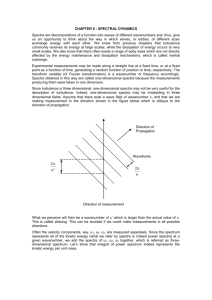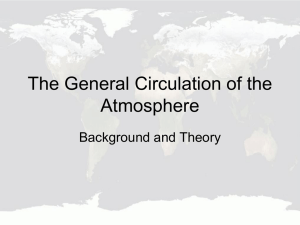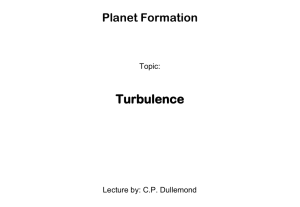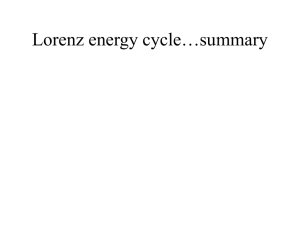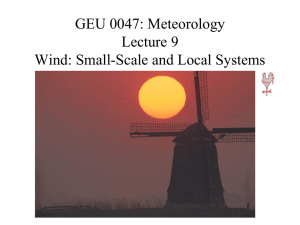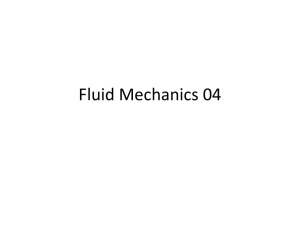Kolmogorov`s universal equilibrium theory
advertisement
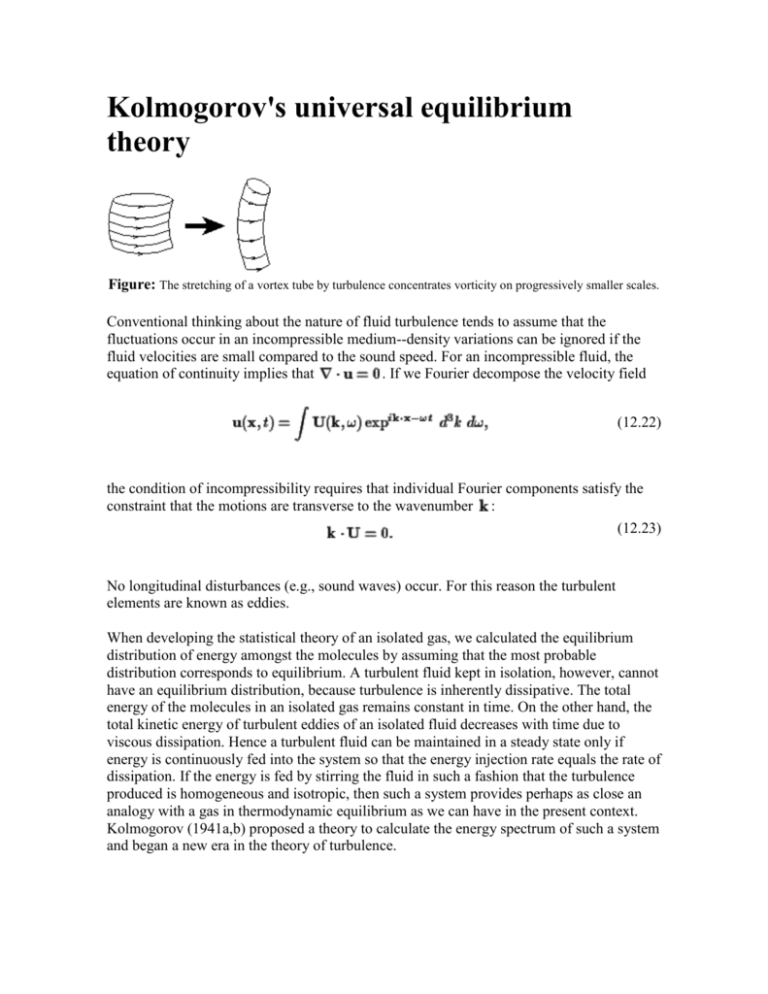
Kolmogorov's universal equilibrium theory Figure: The stretching of a vortex tube by turbulence concentrates vorticity on progressively smaller scales. Conventional thinking about the nature of fluid turbulence tends to assume that the fluctuations occur in an incompressible medium--density variations can be ignored if the fluid velocities are small compared to the sound speed. For an incompressible fluid, the equation of continuity implies that . If we Fourier decompose the velocity field (12.22) the condition of incompressibility requires that individual Fourier components satisfy the constraint that the motions are transverse to the wavenumber : (12.23) No longitudinal disturbances (e.g., sound waves) occur. For this reason the turbulent elements are known as eddies. When developing the statistical theory of an isolated gas, we calculated the equilibrium distribution of energy amongst the molecules by assuming that the most probable distribution corresponds to equilibrium. A turbulent fluid kept in isolation, however, cannot have an equilibrium distribution, because turbulence is inherently dissipative. The total energy of the molecules in an isolated gas remains constant in time. On the other hand, the total kinetic energy of turbulent eddies of an isolated fluid decreases with time due to viscous dissipation. Hence a turbulent fluid can be maintained in a steady state only if energy is continuously fed into the system so that the energy injection rate equals the rate of dissipation. If the energy is fed by stirring the fluid in such a fashion that the turbulence produced is homogeneous and isotropic, then such a system provides perhaps as close an analogy with a gas in thermodynamic equilibrium as we can have in the present context. Kolmogorov (1941a,b) proposed a theory to calculate the energy spectrum of such a system and began a new era in the theory of turbulence. Figure: A schematic representation of the turbulent energy cascade from large to small scales. Hence, L. F. G. Richardson's corruption of Dean Swift's sonnet: ``Big whirls make little whirls which feed on their velocity; Little whirls make lesser whirls, and so on to viscosity.'' The turbulent velocity field can be thought of as being made of many eddies of different sizes. Energy is usually fed into the system in a way to produce large eddies. Kolmogorov's (1941a,b) theory is based on the notion that that large eddies can feed energy to the smaller eddies and these in turn feed still smaller eddies, resulting in a cascade of energy from the largest eddies to the smallest ones. To understand how this cascade may occur, consider the following application of Kelvin's vorticity theorem, which should hold for the larger eddies for which viscous dissipation is not very important. Let and be two fluid elements on a vortex tube as shown in Fig. 12.12. Any fluid element in a turbulent flow moves randomly. When the two fluid elements and move randomly, the separation between them will increase in most cases. Kelvin's theorem dictates that these fluid elements should ``carry'' the vorticity they had. Hence the vortex tube will be stretched as shown in Fig. 12.12. For an incompressible fluid, the cross-section of the vortex tube must decrease in size. In other words, the size of the vortex, as estimated from its transverse dimensions, becomes smaller. This simple argument shows how larger vortices or eddies in a turbulent fluid can give rise to smaller ones. Figure: The spectrum of Kolmogorov turbulence. The spectrum is a power law in the inertial range between the largest scales (small ) where energy is injected and small scales (large viscous dissipation. ) where energy is dissipated by Eddies of a certain size are expected to have some typical velocity associated with them. The corresponding Reynolds number should be large for the larger eddies, as we anticipate the viscosity to be not very important for them. The energy cascades from these large eddies to smaller and smaller eddies (Fig. 12.13). We cannot have eddies of indefinitely small size. For sufficiently small eddies of size Reynolds number is of order unity, i.e., and velocity , the (12.24) and the energy in these eddies is lost to viscous dissipation. Hence, Eq. (12.24) sets a rough limit to the smallest size eddies possible. We now have an outline of a scheme for turbulence: energy must be fed at some rate per unit mass per unit time at the largest eddies of size and velocity , for which the Reynolds number is (12.25) This energy then cascades to smaller and smaller eddies until it reaches eddies satisfying Eq. (12.24), which dissipate per unit mass per unit time in order to maintain the equilibrium. Energy does not build up at any scale; the intermediate eddies merely transmit this energy to the smaller eddies. These intermediate eddies are characterized only by their size and velocity . Since they are able to transmit the energy at the required rate , Kolmogorov (1941 a,b) postulated that it must be possible to express in terms of and . On dimensional grounds, the only way of writing in terms of and is (12.26) from which (12.27) This means that the velocity associated with eddies of a particular size is proportional to the cube root of the size--a result known as Kolmogorov's scaling law. Since Eq. (12.26) should be valid for eddies down to the smallest size, we have (12.28) From Eq. (12.24) and Eq. (12.28), the characteristics of smallest eddies are given by (12.29) Noting that Eq. (12.26) implies that and using Eq. (12.25), we get from Eq. (12.29) (12.30) In other words, the Reynolds number associated with the largest eddies determines how small the smallest eddies will be compared to them. Figure: Wind tunnel experiment at showing velocity fluctuations and the corresponding power spectrum with the characteristic Kolmogorov We now come to the question of the spectrum corresponding to some wavenumber wavenumbers smaller than power law. . Since the largest eddies have the size , we expect that there will be a cutoff at as indicated in the sketch of the spectrum in Fig. 12.14. There will be a cutoff at wavenumbers larger than associated with the smallest eddies. The range of wavenumbers from to is called the inertial range. Within this range, the energy per unit mass per unit time is transferred to smaller eddies (i.e. larger wavenumbers). Hence in the inertial range is expected to depend only on the two quantities and . Dimensional considerations again dictate that this dependence can only be of the form (12.31) in the inertial range. This dependence of on gives the Kolmogorov law. We now argue that Eq (12.31) expresses the same thing as Eq. (12.26). It is implied by Eq. (12.21) that the kinetic energy density associated with some wavenumber around is , which we roughly write as . Then (12.32) Substituting for from Eq. (12.27) with replaced by , we get (12.33) from which Eq. (12.31) readily follows. We have not presented a derivation; we have presented a string of plausible arguments that certain things could be true. But are they really true? Since we do not have a proper theory of turbulence, it is not possible to put Kolmogorov's theory on a rigorous theoretical foundation. The only way of checking the validity of the theory is to determine whether or not experiments confirm the theoretical predictions. The power law can be verified only by doing experiments on a turbulent fluid with a sufficiently large inertial range over which measurements can be made. It follows from Eq. (12.30) that a larger Reynolds number associated with the biggest eddies will give rise to a larger inertial range. In laboratory experiments, it is very difficult to reach high enough Reynolds numbers to produce a sufficiently broad inertial range. One of the first confirmations of Kolmogorov's theory was reported by Grant, Stewart and Moilliet (1962) by conducting experiments in a tidal channel between Vancouver Island and mainland Canada. After this pioneering work many experiments have established the basic soundness of Kolmogorov's ideas, and the dimensionless constant in Eq. (12.31) appears to be a universal constant with a value close to (Monin and Yaglom 1975, p. 485). For example Wind tunnel experiments for subsonic flows show that at high Reynolds number the flow is not steady, but is subject to instabilities which drive velocity, density and pressure fluctuations. Fig. 12.15 shows results from a large wind tunnel experiment, where the fluid velocity is ms and the tunnel diameter is m. The corresponding Reynolds number, .
